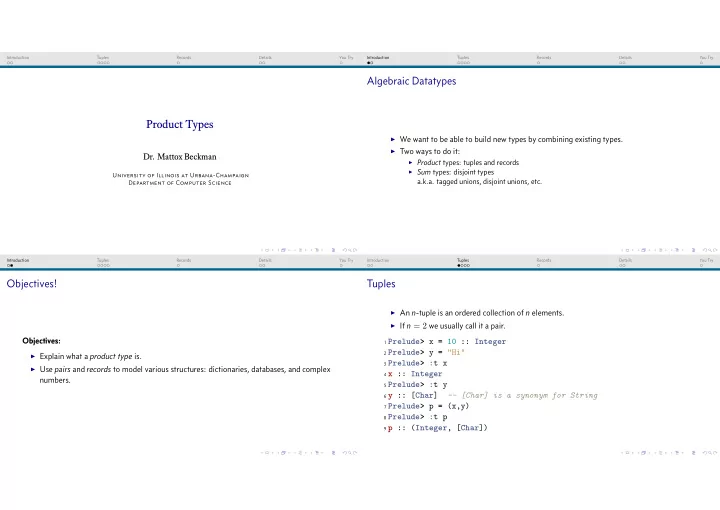

-- [Char] is a synonym for String Introduction Tuples Records Details You Try Introduction Tuples Records Details You Try Algebraic Datatypes Product Types ◮ We want to be able to build new types by combining existing types. ◮ Two ways to do it: Dr. Mattox Beckman ◮ Product types: tuples and records ◮ Sum types: disjoint types University of Illinois at Urbana-Champaign a.k.a. tagged unions, disjoint unions, etc. Department of Computer Science Introduction Tuples Records Details You Try Introduction Tuples Records Details You Try Objectives! Tuples ◮ An n -tuple is an ordered collection of n elements. ◮ If n = 2 we usually call it a pair. Objectives: 1 Prelude> x = 10 :: Integer ◮ Explain what a product type is. 2 Prelude> y = "Hi" 3 Prelude> : t x ◮ Use pairs and records to model various structures: dictionaries, databases, and complex 4 x :: Integer numbers. 5 Prelude> : t y 6 y :: [ Char ] 7 Prelude> p = (x,y) 8 Prelude> : t p 9 p :: ( Integer , [ Char ])
deriving ( Show , Eq ) a * d + b * c) (t, [ Char ], a -> a, (t1, t2)) Introduction Tuples Records Details You Try Introduction Tuples Records Details You Try Projection Functions n -tuples ◮ We have projection functions: ◮ We have n -tuples: 1 Prelude> : t fst 2 fst :: (a, b) -> a 1 Prelude> let p4 = (10,"hi", \ x -> x + 1, (2,3)) 3 Prelude> : t snd 2 Prelude> : t p4 4 snd :: (a, b) -> b 3 p4 5 Prelude> fst p 4 :: ( Num t, Num a, Num t1, Num t2) => 6 10 5 7 Prelude> snd p 8 "hi" Introduction Tuples Records Details You Try Introduction Tuples Records Details You Try Example Record Type Defjnitions Record Syntax ◮ Complex numbers have the form a + bi , where i ≡ √− 1 . data Name = Name { fjeld :: type [ , fjeld :: type …] } ◮ Addition: ( a + bi ) + ( c + di ) = ( a + c ) + ( b + d ) i ◮ Multiplication: ( a + bi ) × ( c + di ) = ac − bd + ( ad + bc ) i 1 data Complex = Complex { re :: Float , im :: Float } 1 cadd (a,b) (c,d) = (a + c, b + d) 2 2 cmul (a,b) (c,d) = (a * c - b * d, ◮ To create an element of type Complex , you have two choices. 3 1. Treat the constructor as a function: We could use tuples to represent complex numbers, like this. (Hint: What are the types of these functions?) Why might this be a bad idea? 1 c = Complex 10.54 34.2 2. Specify the fjeld names: 1 Prelude> : t cadd 1 c = Complex { re = 10.54, im = 34.2 } 2 cadd :: ( Num t, Num t1) => (t, t1) -> (t, t1) -> (t, t1) Each of the fjeld names becomes a function in Haskell. By default, fjeld names must be unique , but Haskell 8.X lets you override this.
, im = im x + im y } [("emergency",911),("jenni",8675309)] , im = re x * im y + re y * im x } , lname :: String , age :: Int } deriving ( Show , Eq ) Person "Harry" "Potter" 19 ] Introduction Tuples Records Details You Try Introduction Tuples Records Details You Try Example: Database Records Haskell creates the fjeld selector functions automatically. ◮ Records are often used to model database-like data. 1 Main> re c ◮ Example: we want to store fjrst name, last name, and age. 2 10.54 3 Main> im c 1 data Person = Person { fname :: String 4 34.2 2 Here are our complex number functions: 3 4 1 cadd x y = Complex { re = re x + re y 5 2 6 people = [ Person "Bilbo" "Baggins" 111, 3 cmul x y = Complex { re = re x * re y - im x * im y 7 4 ◮ The deriving (Show,Eq) allows us to be able to print and test for equality. Introduction Tuples Records Details You Try Some Things to Try ◮ An associative list is a representation of a dictionary that uses a list of key-value pairs. They were commonly used in functional languages. Example: ◮ Write a function add that takes a key, a corresponding value, and an associative list, and returns a new one with the items inserted. For extra fun, have it keep the keys in a sorted order. ◮ Write a function mylookup that takes a key and an associative list and returns the corresponding value. This function will not behave well if the key is not in the list! ◮ Instead of tuples, try defjning a record type with Key and Value fjelds, and use that instead.
Recommend
More recommend